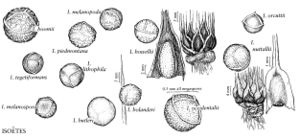Difference between revisions of "Isoëtes lithophila"
Ann. Missouri Bot. Gard. 9: 135. 1922.
Common names: Rock quillwort
Treatment appears in FNA Volume 2.
FNA>Volume Importer |
imported>Volume Importer |
||
| Line 46: | Line 46: | ||
|publication year=1922 | |publication year=1922 | ||
|special status= | |special status= | ||
| − | |source xml=https:// | + | |source xml=https://bibilujan@bitbucket.org/aafc-mbb/fna-data-curation.git/src/bb6b7e3a7de7d3b7888a1ad48c7fd8f5c722d8d6/coarse_grained_fna_xml/V2/V2_642.xml |
|genus=Isoëtes | |genus=Isoëtes | ||
|species=Isoëtes lithophila | |species=Isoëtes lithophila | ||
Revision as of 21:14, 27 May 2020
Plants becoming terrestrial. Rootstock nearly globose, 2-lobed. Leaves deciduous, bright green, pale toward base, spirally arranged, to 12(–20) cm, pliant, gradually tapering to tip. Velum covering entire sporangium. Sporangium wall unpigmented. Megaspores light gray to gray-brown, 290–360 μm diam., obscurely rugulate with low ridges; girdle obscure. Microspores brown in mass, 30–33 μm, tuberculate to spinulose. 2n = 22.
Phenology: Spores mature in winter or spring.
Habitat: Shallow depressions on granite outcrops
Discussion
Isoëtes lithophila is known from granite outcrops in Burnett, Mason, and Llano counties in south central Texas.
Of conservation concern.
Selected References
None.
Lower Taxa
None.

